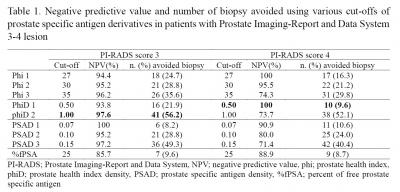|
Cancer - Prostate(구연)
|
(E-149)
|
|
|
Complementing Prostate Biopsy Indication Using Multi-Parametric Magnetic Resonance Image and Prostate Health Index Density |
| Department of Urology, Pusan National University Yangsan Hospital |
| Won Hoon Song, Dan Bee Lee, Seung Ryong Baek, Seung Soo Lee, Jong Kil Nam, Sung-Woo Park |
Objectives; We developed a customized biopsy indication using multi-parametric Magnetic Resonance Image (mpMRI) and prostate health index density (phiD) to reduce unnecessary biopsy for ambiguous visible lesion.
Methods; Two hundred forty cognitive fusion targeted prostate biopsies were performed after mpMRI, and prostate specific antigen (PSA), free PSA, phi, and transrectal ultrasonography. The accuracy of PSA, PSAD, phi, phiD, and %fPSA for the diagnosis of clinically significant prostate cancer (csPCa; Gleason score≥7) was examined using the Receiver Operating Characteristic curve. We estimate the cut-offs of each PSA derivatives for new biopsy indications according to Prostate Image-Report and Data System (PI-RADS) score.
Results; The detection rates of csPCa in PI-RADS 1-2/3/4/5 lesion were 0%/14.9%/49.0%/88.1%, respectively. For PI-RADS 3/4, the area under curves for csPCa diagnosis of PSAD, phi, and phiD were 0.767/0.739, 0.718/0.810, and 0.790/0.809, respectively. The cut-off of phiD in PI-RADS 3/4 lesions was 0.5/1.0, and the negative predictive values was 97.6%/100%.(Table1) The new biopsy indication is set to be performed in only visible lesions, and PI-RADS 3/4 lesions are selectively administered only when phiD ≥ 1.0/0.5.(Table 2) When applied as a new biopsy indication, 71 (29.6%) biopsies could be avoided, and only one case of csPCa was missed.
Conclusion; Only visible lesion in mpMRI can be considered for prostate biopsy. Among them, about 30% of patients with PI-RADS 3/4 lesion can be avoided biopsy without missing csPCa using personalized phiD cut-off. |
  |
|
keywords : prostate specific antigen, biopsy, magnetic resonance image |
|

